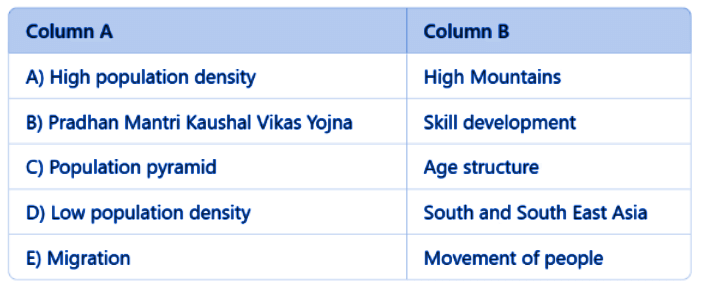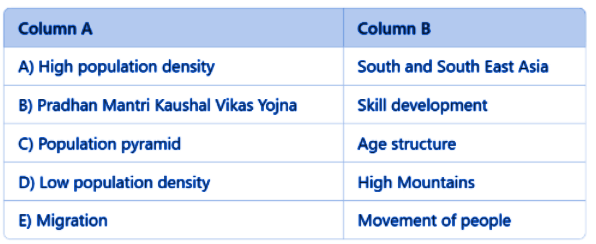Human Resources Class 8 Worksheet Geography Chapter 5
| Table of contents |

|
| Multiple Choice Questions (MCQs) |

|
| Fill in the Blanks |

|
| True or False |

|
| Very Short Answer Questions |

|
| Short Answer Questions |

|

Multiple Choice Questions (MCQs)
Q1: What is the average density of population in India?
A) 51 persons per square km
B) 382 persons per square km
C) 100 persons per square km
D) 600 persons per square km
Ans: B) 382 persons per square km
Q2: Which continent has the highest population density?
A) North America
B) Europe
C) Asia
D) Africa
Ans: C) Asia
Q3: What is the main purpose of the Pradhan Mantri Kaushal Vikas Yojna (PKVY)?
A) To provide health facilities
B) To encourage employable skills
C) To improve agricultural output
D) To reduce population density
Ans: B) To encourage employable skills
Q4: Which of the following countries has a high birth and death rate, leading to high population growth?
A) Japan
B) Kenya
C) United States
D) India
Ans: B) Kenya
Q5: What does the term 'migration' refer to?
A) Change in population density
B) Movement of people in and out of an area
C) Natural growth rate calculation
D) Increase in birth rates
Ans: B) Movement of people in and out of an area
Fill in the Blanks
Q1: The average density of population in the world is ______ persons per square km.
Ans: The average density of population in the world is 51 persons per square km.
Q2: The ______ of population distribution refers to how people are spread across the earth's surface.
Ans: The pattern of population distribution refers to how people are spread across the earth's surface.
Q3: Areas with ______ deposits are more populated due to job opportunities.
Ans: Areas with mineral deposits are more populated due to job opportunities.
Q4: ______ is the number of live births per 1,000 people.
Ans: Birth rate is the number of live births per 1,000 people.
Q5: The ______ of a country refers to the structure of its population.
Ans: The population composition of a country refers to the structure of its population.
True or False
Q1: The world's population is evenly distributed across all continents.
Ans: False
Q2: Fertile soils are less populated compared to deserts.
Ans: False
Q3: The population pyramid helps to understand the age structure of a population.
Ans: True
Q4: High latitude areas are densely populated due to favorable climate.
Ans: False
Q5: Migration can lead to changes in the population size of a country.
Ans: True
Match the Following

Very Short Answer Questions
Q1: What is considered the ultimate resource in a nation?
Ans: Human resource is considered the ultimate resource.
Q2: Which Indian government scheme was launched to train one crore youth?
Ans: Pradhan Mantri Kaushal Vikas Yojna (PMKVY).
Q3: What does population density measure?
Ans: Population density measures the number of people living in a unit area, usually per square kilometer.
Q4: Name one geographical factor that affects population distribution.
Ans: Topography affects population distribution.
Q5: What is the term for people who leave a country?
Ans: Emigrants are people who leave a country.
Short Answer Questions
Q1: What makes people the greatest resource of a nation?
Ans: People are the greatest resource of a nation because they have skills, demands, and abilities. They use nature's resources and turn them into things that help everyone. When people are healthy, educated, and motivated, they can create and develop resources that meet their needs.
Q2: What is population distribution?
Ans: Population distribution is how people are spread out across the earth. Most people live in crowded areas like Asia and Europe, while deserts and high mountains have very few people. This means some places are very busy, and others are quiet.
Q3: What factors affect where people choose to live?
Ans: People choose to live in places that are good for farming, have nice weather, and have fresh water. They also like areas with good schools, hospitals, and jobs. Mountains and very hot or cold places are usually less populated because they are not comfortable to live in.
Q4: How does the population change over time?
Ans: The population changes because of births and deaths. If more babies are born than people die, the population grows. If many people die or not many babies are born, the population can shrink. Movement of people from one place to another also changes the population numbers.
Q5: What does a population pyramid show us?
Ans: A population pyramid shows how many people are in different age groups in a country. It helps us see how many children, working-age people, and elderly people there are. The shape tells us if there are more young people or old people, which helps us understand the country's needs for jobs and care.
|
65 videos|424 docs|46 tests
|
FAQs on Human Resources Class 8 Worksheet Geography Chapter 5
| 1. What is the role of human resources in a company? |  |
| 2. How can effective communication improve human resource management? |  |
| 3. What are the key skills needed for a career in human resources? |  |
| 4. How does employee training benefit a company? |  |
| 5. What are some common challenges faced by human resources departments? |  |



















